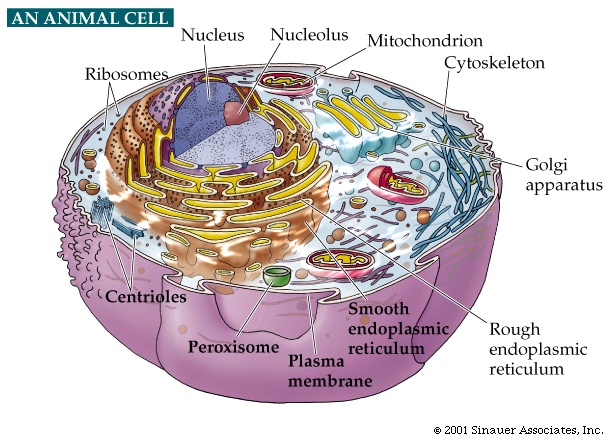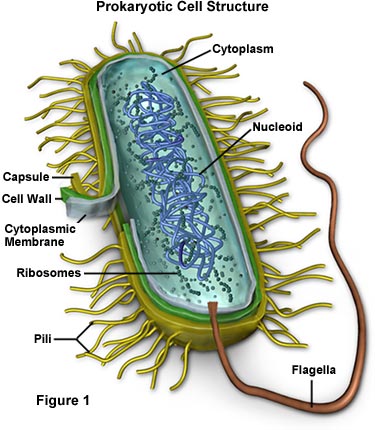Unit One; Chapters 1,2,3,4
Characteristics of Life (pages 2-5)
Molecules of Life (pages 27-36)
Cell Structure and Function (pages 42-53)
Mitochondria and Metabolism (pages 52-55)
Tissue Types (pages 62-69)
Characteristics of Life
All living things share the same characteristics of life. They are biologically organized as follows:
1. Plasma Membrane- regulates the passage of ions and molecules into and out of the cell
Mitochondria are involved in cellular respiration, which uses oxygen and dispels carbon dioxide. During cellular respiration mitochondria process the energy of glucose into the energy of ATP molecules. A "metabolic pathway" is a chain of chain of reactions, each of which has its own enzyme. Enzymes speed up reactions by creating an enzyme-substrate complex. Cellular respiration is a breakdown (enzymatic) of glucose to carbon dioxide and water.
Cellular Respiration:
1. glycolyosis; occurs in the cytoplasm and is anaerobic
2. citric acid cycle; releases carbon dioxide
3. electron transport chain; passes electrons to oxygen
Characteristics of Life (pages 2-5)
Molecules of Life (pages 27-36)
Cell Structure and Function (pages 42-53)
Mitochondria and Metabolism (pages 52-55)
Tissue Types (pages 62-69)
Characteristics of Life
All living things share the same characteristics of life. They are biologically organized as follows:
Atoms join together to create molecules. These molecules then form to make a cell.
Cells are the smallest working unit of a living thing, and therefore the basis of life. Organisms must also rely on an outside source for energy. Food provides energy to maintain cells. Reproducing is another characteristic of life. Cells come only from preexisting cells, therefore, all living things have parents. All organisms undergo development and growth. (An increase in size often means an increase in the number of cells present). Development takes place during all stages of life; from birth to death. Organisms are homeostatic--that is, the organ systems maintain a regulated environment in the body.
Living things all respond to a stimuli--moving toward or away an object. Horses for instance, are prey animals and are generally "hand shy" if they haven't been handled much. A horses response when approached by a human (the stimuli) is then to move out of reach of the human. On the contrary, if a human is approaching a horse with a handful of hay (the stimuli), the response of the horse may be entirely different. The actions of a domesticated horse versus a wild horse represent an adaptation to a change in environment. This is an example of evolution--a process in which a species changes over time. Observations of horses in the wild show that if a member of the herd is feeling sick or fevered it will seek out plants that contain alleviating ingredients. A domestic horse would not have this natural instinct. (source; Andrea Baldwin, Director of Connections Equine Therapy)
In short, all organisms
1. have levels of organization
2. use materials as energy from the environment
3. reproduce
4. grow and develop
5. are homeostatic
6. respond to stimuli
7. evolve
Molecules of Life
There are four categories of organic molecules (those containing hydrogen and carbon) that are unique to cells. These are carbohydrates, lipids, proteins, and nucleic acids.
1. Carbohydrates -made of simple sugars for energy storage
(broken down to simple sugar to fuel cellular metabolism in mitochondria).
Simple sugars lead to serious health problems: obesity, diabetes, cardiovascular disease, immune system dysfunction.
2. Proteins -made with amino acid subunits to speed chemical reactions or account for cell movement
3. Lipids- made of fatty acids for cell membrane function or long term energy storage
4. DNA/RNA Nucleic acids- made of bases or nucleotides for storing and using genetic information, duplicates to pass on information, transcription to mRNA to be translated in a protein’s amino acid chain
Cell Structure and Function
There are two types of cells: Prokaryotic and eukaryotic.
A plant cell is prokayotic. (http://micro.magnet.fsu.edu/cells/procaryotes/images/procaryote.jpg)
An animal cell is eukaryotic. (http://www.columbia.edu/cu/biology/courses/c2005/purves6/figure04-07a.jpg)
The following link http://www.essortment.com/all/prokaryoteseuka_rgbo.htm has an excellent article on the differences between the two cell types.
The human cell is surrounded by a plasma membrane and has a nucleus in the center.
Between the two is the cytoplasm which contains organelles with specific functions.
1. Plasma Membrane- regulates the passage of ions and molecules into and out of the cell
a. passive mechanisms (no energy required) -diffusion (osmosis), facilitated transport
b. active mechanisms (energy required) -active transport, endocytosis, exocytosis
b. active mechanisms (energy required) -active transport, endocytosis, exocytosis
2. Nucleus- (houses DNA), specifies the order of amino acids in proteins
a. chromatin condenses to become chromosomes during cell division
b. the nucleolus produces RNA
a. chromatin condenses to become chromosomes during cell division
b. the nucleolus produces RNA
c. protein synthesis occurs in ribosomes (small organelles composed of protein and rRNA)
3. Endomembrane System
a. Nuclear Envelope-separates nucleus from cytoplasm
b. Endoplasmic Reticulum-protein and lipid synthesis
c. Golgi Apparatus-processes and packages proteins and lipids into other parts of the cell
d. Lysosomes-specialized vesicles produced by Golgi apparatus to digest enclosed material or authodigest old cell parts
a. Nuclear Envelope-separates nucleus from cytoplasm
b. Endoplasmic Reticulum-protein and lipid synthesis
c. Golgi Apparatus-processes and packages proteins and lipids into other parts of the cell
d. Lysosomes-specialized vesicles produced by Golgi apparatus to digest enclosed material or authodigest old cell parts
4. Cytoskeleton- microtubules, actin/intermediate filaments give cells shape and allow organelles to move about cell
5. Mitochondria- cellular respiration and metabolism
Mitochondria and Metabolism
Mitochondria are involved in cellular respiration, which uses oxygen and dispels carbon dioxide. During cellular respiration mitochondria process the energy of glucose into the energy of ATP molecules. A "metabolic pathway" is a chain of chain of reactions, each of which has its own enzyme. Enzymes speed up reactions by creating an enzyme-substrate complex. Cellular respiration is a breakdown (enzymatic) of glucose to carbon dioxide and water.
Cellular Respiration:
1. glycolyosis; occurs in the cytoplasm and is anaerobic
2. citric acid cycle; releases carbon dioxide
3. electron transport chain; passes electrons to oxygen
(this is a great graphic, but I had a hard time formatting it to the blog).
1. Connective Tissue Connects and Supports
a. loose fibrous connective tissue
b. dense fibrous connective tissue (tendons and ligaments)
c. cartilage and bone
d. blood and lymph
2. Muscular Tissue Moves the Body
a. skeletal and cardiac muscle are striated (striped)
b. cardiac and smooth muscle are involuntary
c. skeletal muscle is found in muscles attached to the bones
d. smooth muscle is found in internal organs
e. cardiac muscle makes up the heart
3. Nervous Tissue Communicates
a. composed of neurons and several types of neurolgia (
b. each neuron has dendrites, a cell body, and an axon to conduct nerve impulses
4. Epithelial Tissue Protects
a. squamous-flattened cells
b. cuboidal-cube shaped cells
c. columnar-resembles rectangular pillars or columns
Subscribe to:
Post Comments (Atom)

 (Levels of Biological Organization;
(Levels of Biological Organization; 


1 comment:
plant cells are all eukaryotes. there are both animal-like and plant-like organisms (protists)that exhibit similarities of the cell type they are like, but plant cells are NOT prokaryotes. they are eukaryotes!
Post a Comment